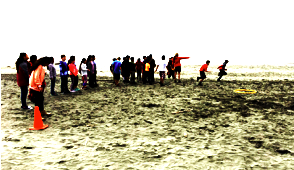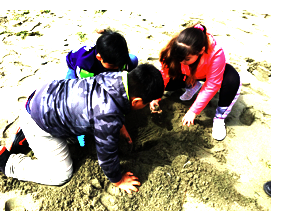The Climate Resiliency Fellows is a program of the Nisqually River Education Project, South Sound GREEN and Chehalis Basin Education Consortium. After the annual Summer Teacher Institute, the Fellows meet quarterly to talk climate science, explore new curriculum and support each other in bringing climate change education into the classroom. Judy Serrano is a teacher at Evergreen Elementary and one of our Climate Resiliency Fellows this year. Thanks for sharing your class’ experiences in the ocean environment, Judy!
“At the beach you can find different things you’ve never seen before that are very interesting and when we learn about these things, it is better to actually see them, hold them, and feel them! We really remember what we learn!”
Lessly, 5th grade student
WOW!!! A day at the beach does wonders for the soul and for our knowledge about food webs and the ocean environment and the part we all play in climate resiliency! Many thanks to Aimee and Mary and the Climate Resiliency Fellows Program for sponsoring an incredible opportunity on May 4, 2017 to take 100 fifth graders to Westhaven State Park in Westport to discover land and marine plants, rocks, marine invertebrates, birds, clouds, and yes, even trash left by humans! Westhaven State Park was a great choice because it provides access to two types of beaches—one with shoreline access to the Pacific Ocean, and one with access to Half Moon Bay. For many of these students, this was their first experience visiting an ocean beach of any kind and I loved watching them discover that yes, the seawater really tastes salty!
Indeed, the day was a busy one with students exploring the two beaches at Westhaven and participating in 4 different activities. At the first station, students scrambled around Half Moon Bay beach carefully gathering items from the beach and placing them on a large Bingo Style template divided into different categories. Students found tickle crabs, lots of bird feathers, shells, an agate, and even a live razor clam that one of our chaperone parents help dig! Using field guides, students learned the the names of both land and sea plants and animals. At a second station at Half Moon Bay Beach, students learned about the tides They role-played the Sun, Moon, Earth and water to learn how each one affects the tides. Then, they used microscopes to see plankton! The third station was on Westport Beach where students saw wide open-sea. It was low tide and many students marveled at the distance between the water and the high-tide mark. It’s one thing to learn about tides in the classroom, but another to actually experience them first hand! On this expansive beach, students played “Food Web Freeze Tag” to learn about herbivores, carnivores and omnivores and the relationship between prey species, predators, and decomposers in a marine environment. Students were amazed about how difficult survival is in an ocean environment, especially if the environment is out of balance! During the last rotation, the “Sand Castle Bonanza,” students showed off their creative talents and teamwork to make incredible sand castles. I know they wanted to believe that the sand castles would last forever, but they understood that the castles would disappear with the high tide!
Learning with meaningful, hands-on experiences in the real world engages students and cements their learning. This meaningful, hands-on beach experience was directly related to our content standards and has left a lasting impression on our students. As our 5th graders grow and mature, we are hopeful they will remember this first-hand experience at the beach and work to keep our environment strong for our future.


